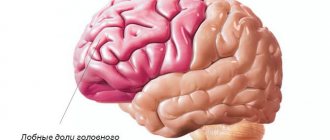Logoneurosis is a convulsive-like movement that spreads throughout the laryngeal and articulatory muscles; they appear at the beginning of speech or in the middle.
The patient stammers at a certain sound, pauses, or drags out the sound. The clinical picture of the pathology resembles tonic or clonic seizures. With tonic logoneurosis, the patient makes a sound stop, and with clonic, he repeats words or sounds. The disease has 4 phases of development; it is a fairly serious personal problem that limits a person’s ability to fully communicate.
Logoneurosis disrupts the rhythm and fluency of a person’s speech. Speech begins to develop in children under one year old, and ends by the age of 7 years. The initial stages of logoneurosis are manifested in the repetition of letters and prolongation of syllables.
Causes of disease in children
Logoneurosis is not associated with disorders or pathologies of the speech apparatus - it is a neurotic form of the disease.
Reference! Logoneurosis is often accompanied by trembling of the jaw, muscle tension of the face, and frequent blinking.
Logoneurosis becomes more pronounced when the child is worried and cannot express his thoughts. For some time, the signs of speech neurosis may recede, and then the child’s speech becomes smooth, however, in a difficult psychological situation, the problem worsens and the intensity of the clinical picture intensifies.
The pattern is that the more nervous the child is, the brighter the signs of logoneurosis, as a result of which a stable chain is formed.
Factors that provoke logoneurosis in childhood:
- Labile nervous system. The child is anxious, whiny, irritable.
- Insufficiency of the central nervous system, resulting from disturbances during intrauterine development, trauma during childbirth, as well as illnesses suffered at an early age.
- Features of individual speech development. Too intensive development of phase speech, too abrupt introduction of a second language at a time when the baby has not yet fully mastered his native language.
- Hereditary weakness of central speech mechanisms.
- Pathogenic external influence that reinforces predisposing factors for the development of speech neurosis.
- Disinhibition of the child’s nervous system, which leads to crumpled and blurred speech, late development of speech.
- Some physical defects that form complexes and feelings of inferiority.
Children at risk:
- to which adults place too high demands;
- whose parents are overly strict, constantly control them, make conflicting demands and do not have a unified upbringing strategy;
- who do not have proper emotional contact, support and care;
- those who have suffered acute stress or psychological trauma.
Hysterical neurosis: causes
As a rule, with this disease, internal unresolved personality problems are transformed into physical symptoms. This mechanism is specific to children, because they are not always able to express what they experience within themselves. Therefore, internal problems begin to express themselves in bodily form.
Many researchers see the cause of the disease in the attitude of parents towards their child.
Doctor of Psychological Sciences A.I. Zakharov claims that the roots of the disease are hidden in the inconsistent upbringing of parents. For example, a mother may allow her child to eat candy before breakfast, but a father or grandmother may prohibit it. The child experiences a kind of pedagogical dissonance, which manifests itself in a mental disorder.
Nervous and psycho-emotional stress in the body also contributes to the development of the disease. Provoking factors may be:
- frequent conflicts in the family;
- “intimidating” parenting style (“if you don’t go to bed, an evil wolf will come and eat you,” “if you pick up a knife, you’ll accidentally cut off your finger,” etc.);
- psychotraumatic situations (fear of the dark);
- sudden change in environment or living conditions;
- long-term stress.
Hysterical neurosis - symptoms in children are possible due to a complete lack of parental attention and education. Such children are deprived of emotional return, they have an attention deficit.
Thus, as a result of incorrect behavior of parents, a child may develop one of the forms of neuroses: hysterical, asthenic (weakness, causeless fatigue), obsessive, depressive.
According to statistics, most children's psychological and mental problems are based on the pedagogical ignorance of parents.
Symptoms in children
Speech neurosis is characterized by pauses during a conversation; in addition, signs of pathology may be as follows:
- the child repeats certain sounds, syllables or words several times;
- there are problems with the pronunciation of certain syllables or words;
- spasms of the larynx are observed;
- lack of air.
Along with the listed signs, the child has respiratory and articulatory convulsions, and also observes:
- feeling of fear;
- increased anxiety;
- low self-esteem;
- increased sweating;
- restless sleep.
In some cases, when pronouncing syllables or words, the child’s facial expression changes, and grimaces and tics may appear.
Treatment in children
The diagnosis and treatment of logoneurosis is carried out by a speech therapist; in addition, consultation with a psychologist, psychiatrist and therapist is necessary. It is very important to study the baby’s heredity and the circumstances that provoked the development of pathology. After the form of speech deviation and its root cause are determined, the doctor examines phonemic hearing, lexico-grammatical speech and sound pronunciation.
Treatment is aimed at stopping too much stimulation of the child’s nervous system. For this, different approaches are used - herbal medicine, physiotherapy, reflexology.
If, after a course of treatment, improvements are observed in the child’s psychological state, restoration of normal functioning of the speech apparatus becomes possible.
Drug treatment for a child is selected taking into account the degree of neurological disease. Perhaps the doctor will prescribe drugs that affect the activity of brain processes, tranquilizers, sedatives, vitamins.
Important! Only a doctor can prescribe medications; independent drug treatment is strictly contraindicated.
You should not rely too much on medications; the pathology often returns as soon as the therapeutic course ends. Therefore, during the treatment of an illness, it is extremely important to find and eliminate the root causes of the pathology.
Massage for logoneurosis can only be performed by speech therapists, since it is very important to know the mechanism of the speech apparatus. Acupressure massage shows good results; if stuttering intensifies after the massage, this indicates a severe pathology.
Breathing exercises help normalize the breathing rhythm and also strengthen the child’s muscles. Physical activity is indicated in the morning.
Important! You should not think that logoneurosis will cure itself when the child grows up. Unfortunately, this phenomenon is quite rare; most often, without treatment, speech neurosis remains with the child for life, and significantly reduces his self-esteem.
To prevent pathology, it is necessary to create a peaceful environment in the family, it is advisable not to raise your voice at the child, and to point out mistakes in a friendly tone. Parents are advised to speak calmly and smoothly. It is important to follow a daily routine; in the evening you should not turn on cartoons for your child or play noisy games. It is necessary to exclude reading scary fairy tales that can frighten a child.
Treatment of situational neurosis
The main thing to do when getting rid of an illness is to try to eliminate the negative situation that caused the illness. A visit to a psychotherapist is recommended to change the attitude towards this problem and find a way out of traumatic situations.
There are two types of psychotherapy:
- Casual, when the patient must understand why such a disease occurs, and also find ways to solve this problem.
- Rational – a method of strengthening and developing the patient’s intellect. This is a way to re-educate a person. The cause of neurosis is often a very impressionable attitude to various situations. When teaching a patient the correct reaction to certain life moments, a specialist teaches him to control himself and find a cause-and-effect relationship - how and why the disease appeared and how to get rid of it and prevent its occurrence in the future. Such psychotherapy is effective for situational neurosis.
Drug therapy is also used in the treatment of pathology. It is designed to normalize the main processes of the nervous system - excitation and inhibition. Drugs such as “Elenium”, “Napoton”, “Seduxen”, “Tazepam” are used, but only a qualified doctor has the right to prescribe them after examination and determining the degree of manifestation of the disease.
Physiotherapeutic measures, such as pine-salt baths, wet wraps and massage, will also be useful in the treatment of neurosis. Light gymnastics and sports games will also help reduce the degree of nervous tension.
Situational neurosis (according to ICD 10 F34-F68) must be treated immediately, since once the disease develops into the fourth stage, it is almost impossible to cure.
Causes of the disease in adults
As a rule, speech neurosis develops in childhood or adolescence; the causes that provoke the disease are individual and both hereditary and neurological factors can contribute to it.
Prerequisites for the development of logoneurosis in adulthood may be:
- Neurological or organic causes - brain lesions in which softening areas form. Speech neurosis can develop after injury, stroke, circulatory problems in the brain, or infection. In some cases, treatment of the underlying disease eliminates logoneurosis, but it cannot be said that this always happens.
- Neurotic or psychogenic factors - manifest themselves in connection with mental trauma, as well as when the nervous system is unbalanced. Such logoneuroses belong to a complex group of ailments that require an individual approach, and there is no single recipe for getting rid of the disease.
Clinical picture in adults
Signs of speech neurosis can be combined under one concept: “stuttering”:
- repetition of syllables or words that a person cannot control or interrupt by force of will;
- stretching letters and syllables, lengthening words;
- increased speech volume, the patient has difficulty with the first syllable, so he tries to pronounce it as loudly as possible;
- facial muscle tension;
- breathing spasm;
- additional movements of the arms or body, as if the person is helping himself to pronounce the word;
- increasing the intensity of facial expressions.
A characteristic sign of speech neurosis is spastic breathing . Since the respiratory apparatus is closely connected with the vocal apparatus, convulsive compression of the larynx leads to the fact that speech becomes intermittent. When you try to speed up your speech, the situation worsens and speech hesitations become more pronounced.
It is interesting that the patient’s thoughts and inner speech do not suffer - there are no stops, all spoken words “to oneself” are smooth and clear. A person encounters problems only when trying to say a thought out loud; this phenomenon confirms the neurotic nature of the pathology. Problems with speech certainly affect a person’s behavior; he shuns society and strangers, but in the circle of relatives and friends, where he does not have to fear ridicule or misunderstanding, problems with speech become almost invisible.
Treatment in adults
Treatment is aimed at restoring the proper functioning of the nervous system, so doctors use herbal medicine, reflexology, physiotherapy, and medications (Glycine, Novo-passit).
The treatment will be determined by a neurologist after a thorough examination of the patient. Complex treatment is often used - taking sedatives, traditional medicine, manual therapy, massage, acupuncture.
The listed methods significantly improve the patient’s emotional background, help normalize nerve impulses, reduce excitation of the autonomic nervous system, and improve mood and sleep.
Speech therapy treatment is also mandatory. With the help of a speech therapist, the patient learns proper breathing, which significantly reduces the symptoms of the disease.
In some cases, the problem is partially eliminated, or stuttering returns after a course of therapy. Then more serious treatment is needed. We need the help of a psychotherapist who will show the patient relaxation and auto-training techniques, help overcome fears and minimize the consequences of psychological trauma. Are used:
- group therapy;
- autogenic training;
- cognitive behavioral therapy;
- Gestalt therapy.
Medications that may be prescribed include:
- Pantogam;
- Piracetam;
- Phenibut;
- Phenotropil;
- Noofen;
- Anvifen;
- Gopantam and other nootropic drugs.
How does logoneurosis differ from stuttering?
Logoneurosis is a type of stuttering. In general, there are two large groups of stuttering:
- neurotic – logoneurosis;
- neurosis-like or organic.
With neurotic stuttering, pathologies from neuralgia are not observed, and disturbances in the study of the brain and its functionality are also not observed.
Most often, patients with logoneurosis practically do not stutter in a calm environment; problems begin with anxiety and excitement. As for neurosis-like or organic stuttering, it is a consequence of a clear neurological pathology, and doctors often identify deviations in the functionality of the brain.
In childhood, a child’s motor skills develop poorly, which certainly affects articulation. With organic stuttering, speech is convulsive, accompanied by obsessive movements and vivid nervous tics.
However, it must be said that such a division is very arbitrary, and almost always a person with logoneurosis suffers from somatic disorders. Therefore, in the treatment of both groups of stuttering, basically the same methods are used.
Is it possible to get a license if you have logoneurosis? Logoneurosis is not a contraindication for obtaining a car license, of any category. But only if a speech disorder is the main and only ailment.
Neurotic depression: symptoms
Neurotic depression, the symptoms and treatment of which are determined by the type of disorder, is psychogenic in nature. The first signs of the pathological process are: loss of strength and negative emotional state. Patients diagnosed with neurotic depression turn to psychiatrists with complaints of increased irritability and anxiety, regular headaches and insomnia.
With this disorder in patients, anxious thoughts can become obsessive or develop into phobias; the most dangerous sign of neurotic depression is thoughts of suicide. Neurotic depression significantly affects the patient’s quality of life and his physical condition, so if left untreated, joint pain, disturbances in the intimate area, and gastrointestinal disorders may appear.
Depression of situational or neurological origin requires complex treatment, however, patients with these disorders tend to ignore treatment and contact a psychiatrist. Specialists at the Yusupov Hospital interact with relatives of people suffering from mental disorders and help them develop tactics for interaction and assistance.
ICD-10 code
According to the International Classification of Diseases, logoneurosis is assigned the code F-98.5.
Correction of neurotic stuttering is a complex and rather lengthy process; treatment should be carried out not only by a speech therapist, but also by a psychotherapist, neurologist and psychologist.
Since the development of pathology is based on psychotrauma, the individual work of a speech therapist will be ineffective as long as the psychotraumatic situation continues to affect the patient.
If there are problems in the family of a child with logoneurosis, the help of a psychotherapist will be very useful, who will help establish a microclimate in the family , which will give the child the opportunity to relax and feel more calm and confident. A psychologist will explain how to get rid of provoking psychological factors, and a neurologist will prescribe treatment that stops convulsive readiness.
Hysterical neurosis - symptoms and manifestations
The disease is manifested by the baby’s complaints about any physical problems. The disease is characterized by frequent headaches, the causes of which are not explained by somatic diseases. Parents can conduct many tests and examinations on their child, but still not identify the cause of headaches or discomfort.
The following symptoms are observed in younger schoolchildren:
- physical pain;
- academic performance drops sharply;
- sudden changes in the student’s interests;
- indifference to previously favorite activities;
- problems communicating with peers;
- outbursts of aggression and anger;
- anxiety states;
- sleep and appetite disturbances.
Hysterical neurosis in children and adolescents is associated with a demand for attention from people around them. The child seems to attract attention with his screams and crying. In this case, parents cannot immediately fulfill the demands of their offspring; it is important to remain calm and not succumb to provocations, and not begin to react emotionally in response.
Hysterical neurosis in adolescents is expressed in increased conflict, demonstrative behavior, hot temper and aggression. Hysterical attacks manifest themselves as follows: the patient throws things around the house, can throw household items against the wall, scream and cry.











